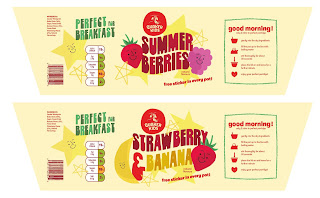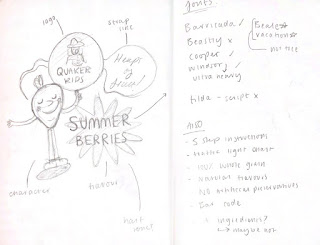What is The Relationship Between Brands And Consumer Lifestyles?
Fast food brands have particularly interesting connections with their consumers as they have managed to become so successful while being unethical in terms of healthy living. Eric Schlosser writes in Fast Food Nation (2001) that ‘The golden arches are now more widely recognised than the christian cross’ despite the rapid rise in obesity and changes of attitude towards fast food (fig. 1). Why is food that is so bad for our health as well as the environment so popular? The answer lies in the branding and how the product is marketed towards the consumer. Exploring the techniques used by brands to sell their products leads to questioning their ethics as well as how we, as consumers, use brands as a reflection of ourselves.
The whole point of branding is to be able to engage with the consumer to persuade them to buy the product at hand. Wally Ollins says in his book On Brand (2003): ‘Some of the cleverest brands, the ones that are managed by the people with sensitive antennae, are reaching out to create a relationship with society.’ This relationship Ollins speaks about is the successful product of good branding, and is what keeps a brand alive. Powerful brands use all-inclusive emotions to be successful worldwide, and they use advertising with social content that connects with people. Take for example Pepsi’s 2017 “Live For Now” advert (Fig. 2) that received a lot of backlash due to its failed attempt at using the language and the imagery of protest movements to connect with its audience. Pepsi mis-read their place within the current political climate and so faced a negative reaction from their audience, but this is a good example of brands trying to reach out through social commentary.
Furthermore, brands are putting more effort into their relationships specifically with children, and this is made very clear through the statistics that David Boyle discusses in his novel Authenticity: Brands, Fakes, Spin and the Lust for Real Life (2003). Boyle reveals the extent that fast food brands in particular go to to connect with children. For example, 95% of the advertisements on children's channels contain food and drink that are high in fat, sugar, and salt. Moreover, ‘In the USA, McDonald's and Burger King run more than 10,000 playgrounds between them’ and even school’s textbooks are sponsored by fast food giants. It is shocking that these companies' main target audience is children, as their products are so unhealthy, yet unfortunately this is who they appeal to most and therefore where the money comes in. They also make no discretions when it comes to marketing their products towards a younger audience.
In comparison to healthy food brands, it is shocking to see how these fast food brands are steered towards children, and when their success rate is taken into account, it is no wonder why Americans spend more on more on fast food than they do on education. Despite the success of these brands being on a global scale, it is actually down to a few simple methods that Kate Bratskier outlines in her article The Tricks Fast Food Companies Use to Lure You in (2014). First, convenience - according to a 2006 Eating Patterns In America report released by The NPD Group, Americans will spend money on unhealthy food if it is made for them because they value convenience over their own health, and even, their children’s. Second, the mouthwatering vocabulary. Brands love to tell consumers what they want them to taste, for example, Subway’s “Eat Fresh!” (Fig. 3). Third, the colours of the brand play an important part of consumer psychology. Studies have shown that warm colours such as red and yellow activates hunger as well as grab attention, this is why these colours are used in the iconic McDonald’s logo (fig. 1) as well as others like Pizza Hut (Fig.4) and In-N-Out (Fig. 5).
The effect that these branding strategies have on society is extreme and dangerous for people’s health because they produce such a high selling rate. Ed Mayo and Agnes Nairn discuss the repercussions of fast food chains in their book Consumer Kids: How Big Business is Grooming Our Children for Profit (2009). From a societal point of view brands reflect who we are as people and help us ‘fit in’ with others. Parents don’t want their children to ‘go without’ and will follow consumer culture by buying unhealthy snacks and taking their children to fast food restaurants; ‘the food industry has products for all of this, competing for space in the lunchbox, knowing that it is easier to put snacks in, even if they are less healthy’. Due to fast food chains like Mcdonald’s playing up to this notion with products such as The Happy Meal (fig. 6) four year old children have double the amount of salt in their food that health professionals recommend, as well as cases of children as young as 5 with type 2 Diabetes. This shows that the branding strategies used by fast food conglomerates are working hard to market their products specifically towards children but poses the question: are they ethical?
The answer to that question is no, and this is proven by the fast food businesses response to Ofcom’s research that revealed “foods high in fat,sugar, and salt account for 80-90 per cent of all TV food advertising spend” (Mayo, Nairn 2003). The response from the Food Advertising Unit, who are controlled by fast food companies with enormous research budgets, was to pay other academics to discredit the findings. This proves that the companies themselves do not believe that their products are healthy, and in turn know the damage that their global success causes, yet still hire people to lie and suggest that they are. Furthermore, even when rules are applied they do not go far enough. Markham Held discusses in his article How Food Labels Lie to You (2017) about how there is no legal definition of words like ‘natural’ so companies can trick consumers into buying their products.
Somehow, fast food corporations have managed to spread ‘throughout the country like a self replicating code.’ (Schlosser, 2001). Despite being proven to be bad for your health. In recent years, however, consumers have begun to demand differences from them. The brands we buy from are a reflection of the type of person we are, so, as people begin to make changes brands do the same. For example, more and more fast food restaurants are offering vegetarian and vegan options, encouraged by those trying to be more sustainable and cutting out meat. Despite this, it is arguable that buying into these products still supports the larger idea and therefore makes little difference in the long run.
To summarise, a final quote from Ed Mayo and Agnes Nairn’s book Consumer Kids: ‘The moral is that if you want to encourage responsible advertising to children, then you have to take an approach that addresses the full mix of marketing and not just a part of it’. Thus meaning that it is not simply the advertising that is the problem - the issue lies within the brands themselves, it is imbedded within their individual ethos’. If people stop demanding change from fast food companies, they will continue to have a negative impact on society as a whole.
Images
Fig. 1, McDonald’s Logo
Fig. 2, Pepsi Advert
Fig. 3, Subway’s Logo and Tagline
Fig. 4, Pizza Hut’s Logo
Fig. 5, In-N-Out Burger’s Logo
Fig. 6, McDonald’s Happy Meal
Reference List
Boyle, D. (2003) Authenticity: Brands, Fakes, Spin and the Lust for Real Life. Harper Perennial.
Bratskier, K. (2014) The tricks fast food companies use to lure you in. Available at:
Held, M. (2017) How Food Labels Lie to You. Available at:
Nairn, A. and Mayo, E. (2009) Consumer Kids: How Big Business is Grooming Our Children for Profit. Constable.
Olins, W. (2003) On Brand. Thames & Hudson Ltd.
Schlosser, E. (2001) Fast Food Nation: The Dark Side of the All-American Meal. Penguin.


































